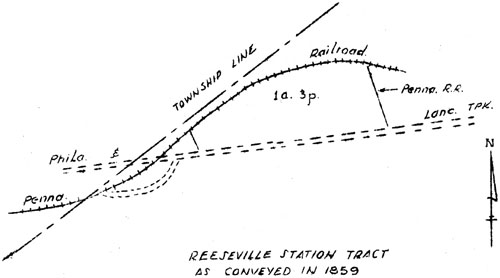|
Home : Quarterly Archives : Volume 4 |
Tredyffrin Easttown Historical Society |
|
Source: January 1941 Volume 4 Number 1, Pages 12–13 Local titles in Easttown and Tredyffrin : Article VII : The Reeseville Station tract Of the large tract conveyed by G5 - 242 to John Kugler, the following piece was sold by him and his wife, Hannah, to The Pennsylvania Rail Road Company in 1859 for a consideration of $150. Beginning in the middle of the Pennsylvania Rail Road, thence by other land of said John Kugler S. 21 1/4° E. 215' to the middle of the Philadelphia and Lancaster Turnpike, thence along the middle of the same S. 79° 40' W. 365', thence by land of Stephen D. Hunter N. 32 1/4° W. 112' to the middle of the Pennsylvania Rail Road and thence along the middle of the same 358' to beginning. Containing 1 a. and 3 p. L6 - 397. Evidently the purchase was for a station at the small village of Reeseville. The present brick building followed a small box-like wooden structure a number of years later.
Reeseville Station Tract as conveyed in 1859 The old Ewing store building and the home of Mr. and Mrs. Frank P. Mattson, to which references have been made in prior articles, were standing at the time of this purchase by the railroad. The front and larger portion of the latter house is made from rectangular, faced wooden blocks, now covered with plaster. The eastern portion of this tract was sold to Joseph C. Smith in 1848 for $700. As there was a house on the lot at the time, there may be some question as to which is the older, the rear stone portion of the old store property or the original part of the house to the east. Apparently it was this Joseph C. Smith who purchased the thirty acres along the east side of the 250 acre tract and whose family for years owned the farm ground on both sides of the railroad in the neighborhood of the Wynburne Inn. A later owner of the house to the east was Charles Thompson, in 1852, described as a railroad superintendent. A good deal of the ground extending back to Berwyn Avenue was later owned by Mr. Thompson or his family. Mr. Henry Fritz, a successful builder, who was later to lose his life in saving that of a woman at the old Eagle railroad crossing, bought what is now the lumber yard from the Reverend John McLeod immediately east of the station tract, in 1866. Across the turnpike from the station lot and the Fritz ground, a large piece of the Spring House Tavern tract was sold by Dr. McLeod to William Clark of Philadelphia in 1862. The deed shows that Dr. McLeod had laid out Main Avenue and Berwyn Avenue extending from it to Newtown or Waterloo Road. Except for a lot containing 15,000 square feet belonging to Trinity Church in Reeseville, Dr. McLeod took this land back in 1864 and continued his interesting real estate development. An important sale was to the late Isaac A. Cleaver, who owned a farm near the Leopard and became a prominent and influential member of the community. He operated a successful store in the rear of the present Landis Building. Following its burning fifty years or so ago, Mr. Cleaver built the large store still standing in the rear of the present post office and drug store. This store was a veritable emporium of the early nineties with its several floors, well stocked grocery and dry goods counters and traveling backers (sic, but believe the word should be buckets) moving over wires leading to an elevated central office. With the genial merchant and postmaster ever in the foreground, and never too busy to greet his customers, however small and unimportant, its like will not be seen in Berwyn again, The passing of the business and removal of the Cleaver family left a noticeable gap in the life of the community. We have it on the authority of Mr. F. L. Burns that Mr. Cleaver, a strict church member, received word one Sunday that someone who proved to be the prominent Samuel J. Randall, then or later Speaker of the Democratic Congress, wished to see his farm. With considerable misgiving, Mr. Cleaver resolved his inherent doubt as to the propriety of the visit on the day in question in favor, let us say, of courtesy. He met Mr. Randall at Reeseville Station, drove him to the farm and then or later rented the farm house to him as a summer home. Thus began a friendship which was to hold this staunch Republican in the postmastership for a considerable period during the Cleveland administration. A close neighbor of Mr. Randall was the late Dr. Julius F. Sachse who lived at the Leopard and had his justice's office in what is now Mr. Preston's shoe shop; then standing on the north side of the turnpike, near the Fritz property. Who, among the prophets of the time, would have conceived that Dr. Sachse's mild diversion of recording historical events with facile pen and ready camera carried for miles along our dusty roads with horse and buggy, would have established him as a public benefactor of increasing importance as the things of which he wrote pass rapidly from view? Who, but those old enough to know from personal recollection, even know of Mr. Randall's existence? Much less that for years he was a celebrity in our midst. Assuredly there, here, is food for thought. |
